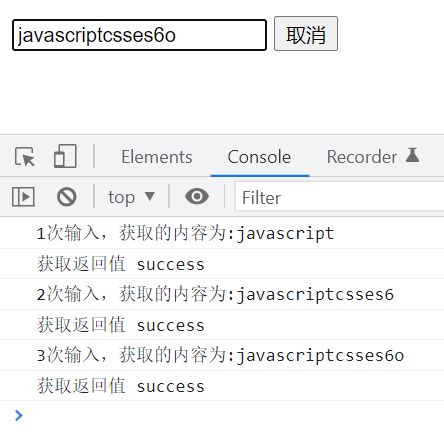节流定义
某些频繁操作的事件会影响性能,"节流"用来控制响应的时间间隔,当事件触发的时候,相对应的函数并不会立即触发,而是会按照特定的时间间隔,每当到了执行的响应间隔时,才会执行响应函数。
节流案例
网络游戏中的"飞机大战",键盘按键可以用于发射子弹,快速不停的敲击键盘,飞机不会不停的发射,而是以一定的时间间隔,来控制子弹与子弹的距离。比如系统设定一秒钟发射一次子弹,那么即使你在一秒钟内敲击了20次键盘,仍然只会发送1次子弹。
节流使用场景
在程序设计的过程中,很多场景都能够用到"节流"。
- 输入框频繁输入、搜索
- 按钮频繁点击、提交信息,触发事件
- 监听浏览器的滚动事件
- 监听浏览器的缩放事件
没有使用节流时
这里模拟一个商品搜索框,我们需要对用户输入的内容调用接口进行关联查询,来给用户进行搜索提示。
当没有使用防抖时,我们会直接将函数绑定到对应的事件上。
// html
// js代码
const inputEl = document.querySelector("input");
let count = 0;
function inputEvent(event) {
console.log(`${++count}次输入,获取的内容为:${event?.target?.value}`);
}
inputEl.oninput = inputEvent;input框内输入"javascriptcsses6",一共16个字符,所以方法调用了16次
这样的方式性能很低,因为每输入一个字符就调用接口,对服务器造成的压力很大,"节流"的作用按指定时间执行函数,避免了多次执行造成的资源浪费。
自定节流函数
节流函数实现的原理是,按照指定的时间间隔来执行函数。
第一步:基本版节流实现
判断当前与上一次执行函数的时间间隔,如果超过了指定的时间间隔,就执行函数。
function throttle(fn, interval) {
// 将初始时间定为0
let startTime = 0;
const _throttle = function () {
// 获取当前时间
let currentTime = new Date().getTime();
// 获取剩余时间(当前时间与指定间隔的距离)
let restTime = interval - (currentTime - startTime);
// 剩余时间小于等于0时,执行函数
if (restTime <= 0) {
// 执行传入的函数
fn();
// 将当前时间赋值给初始时间
startTime = currentTime;
}
};
return _throttle;
}
inputEl.oninput = throttle(inputEvent, 2000);这里指定的时间间隔为2秒钟,即2秒钟执行一次函数。
但此时我们发现,参数没有被传递过来,实际上this的指向也不对了
第二步:拓展this和参数
通过apply方法来改变this的指向,以及传递参数
function throttle(fn, interval) {
// 将初始时间定为0
let startTime = 0;
const _throttle = function (...args) {
// 获取当前时间
let currentTime = new Date().getTime();
// 获取剩余时间(当前时间与指定间隔的距离)
let restTime = interval - (currentTime - startTime);
// 剩余时间小于等于0时,执行函数
if (restTime <= 0) {
// 通过apply改变this的指向和传递参数
fn.apply(this, args);
// 将当前时间赋值给初始时间
startTime = currentTime;
}
};
return _throttle;
}此时this和参数都已经可以获取到了~
到这里为止,已经实现了节流的大部分使用场景,下面的功能会更为复杂。
第三步:函数立即执行
在上面的函数定义中,输入第一个字符时,函数大概率会执行的,因为输入第一个字符的时间减去初始化的时间0秒钟,一般会大于设定的时间间隔。
如果觉得在输入第一个字符时的函数执行没有必要,那么可以自定义参数,来控制函数是否会立即执行。
参数 leading 控制函数立即执行,默认为true。
function throttle(fn, interval, options = {}) {
let startTime = 0;
// leading默认值设置为true
const { leading = true } = options ;
const _throttle = function (...args) {
let currentTime = new Date().getTime();
// 不需要立即执行时,将初始值为0的startTime修改为当前时间
if (!leading && !startTime) {
startTime = currentTime;
}
let restTime = interval - (currentTime - startTime);
if (restTime <= 0) {
fn.apply(this, args);
startTime = currentTime;
}
};
return _throttle;
}
// 传入leading参数
inputEl.oninput = throttle(inputEvent, 2000, {
leading: false,
});这样就会等待2s才会执行第一次函数调用
第四步:函数最后一次执行
"节流"只和函数的间隔时间有关,和最后一个字符输入完成无关。
所以最后一个字符输入完成后,与上一次函数调用的时间间隔如果没有到指定的时间间隔时,此时函数是不会执行的。如果需要执行,需要自定义参数来控制函数执行。
通过参数 trailing 控制函数最后一次执行,默认为false。当函数需要在最后执行时,在每个时间间隔还没有到执行时设置计时器,等到了时间间隔执行函数时,清空计时器,如果最后一个字符输入后还没有到指定间隔,则执行计时器中的内容。
function throttle(fn, interval, options = {}) {
let startTime = 0;
// 设置一个计时器
let timer = null;
// leading默认值设置为true,trailing默认值设置为false
const { leading = true, trailing = false } = options;
const _throttle = function (...args) {
let currentTime = new Date().getTime();
// 不需要立即执行时,将初始值为0的startTime修改为当前时间
if (!leading && !startTime) {
startTime = currentTime;
}
let restTime = interval - (currentTime - startTime);
if (restTime <= 0) {
// 当存在计时器时,清空计时器
if (timer) {
clearTimeout(timer);
timer = null;
}
fn.apply(this, args);
startTime = currentTime;
// 执行完成就不再执行下面计时器的代码,避免重复执行
return;
}
// 如果需要最后一次执行
if (trailing && !timer) {
// 设置计时器
timer = setTimeout(() => {
timer = null;
fn.apply(this, args);
// 当需要立即执行时,开始时间赋值为当前时间,反之,赋值为0
startTime = !leading ? 0 : new Date().getTime();
}, restTime);
}
};
return _throttle;
}
// 传入leading、trailing参数
inputEl.oninput = throttle(inputEvent, 2000, {
leading: false,
trailing: true,
});此时输入完最后一个字符,等待计时器中设置的时间间隔(restTime),函数会再次执行。
第五步:取消功能
可能存在这样的场景,当用户搜索时点击了取消,或者关闭页面,此时就不需要再发送请求了。
我们增加一个取消按钮,点击后终止操作。
// html
// javascript
function throttle(fn, interval, options = {}) {
let startTime = 0;
// 设置一个计时器
let timer = null;
// leading默认值设置为true,trailing默认值设置为false
const { leading = true, trailing = false } = options;
const _throttle = function (...args) {
let currentTime = new Date().getTime();
// 不需要立即执行时,将初始值为0的startTime修改为当前时间
if (!leading && !startTime) {
startTime = currentTime;
}
let restTime = interval - (currentTime - startTime);
if (restTime <= 0) {
// 当存在计时器时,清空计时器
if (timer) {
clearTimeout(timer);
timer = null;
}
fn.apply(this, args);
startTime = currentTime;
// 执行完成就不再执行下面计时器的代码,避免重复执行
return;
}
// 如果需要最后一次执行
if (trailing && !timer) {
// 设置计时器
timer = setTimeout(() => {
timer = null;
fn.apply(this, args);
// 当需要立即执行时,开始时间赋值为当前时间,反之,赋值为0
startTime = !leading ? 0 : new Date().getTime();
}, restTime);
}
};
// 在函数对象上定义一个取消的方法
_throttle.cancel = function () {
// 当存在计时器时,清空
if (timer) {
clearTimeout(timer);
timer = null;
// 重置开始时间
startTime = 0;
}
};
return _throttle;
}
// 获取dom元素
const inputEl = document.querySelector("input");
const cancelBtn = document.querySelector("button");
const _throttle = throttle(inputEvent, 2000, {
leading: false,
trailing: true,
});
// 绑定事件
inputEl.oninput = _throttle;
cancelBtn.onclick = _throttle.cancel;当点击了取消之后,就不会再执行计时器的内容
第六步:函数返回值
上面的"节流"函数执行后都没有返回值,如果需要返回值的话,有两种形式。
回调函数
通过参数中传递回调函数的形式,来获取返回值。
function throttle(fn, interval, options = {}) {
let startTime = 0;
// 设置一个计时器
let timer = null;
// leading默认值设置为true,trailing默认值设置为false,传入回调函数用于接收返回值
const { leading = true, trailing = false, callbackFn } = options;
const _throttle = function (...args) {
let currentTime = new Date().getTime();
// 不需要立即执行时,将初始值为0的startTime修改为当前时间
if (!leading && !startTime) {
startTime = currentTime;
}
let restTime = interval - (currentTime - startTime);
if (restTime <= 0) {
// 当存在计时器时,清空计时器
if (timer) {
clearTimeout(timer);
timer = null;
}
// 获取执行函数的结果
const result = fn.apply(this, args);
// 执行传入的回调函数
if (callbackFn) callbackFn(result);
startTime = currentTime;
// 执行完成就不再执行下面计时器的代码,避免重复执行
return;
}
if (trailing && !timer) {
timer = setTimeout(() => {
timer = null;
// 获取执行函数的结果
const result = fn.apply(this, args);
// 执行传入的回调函数
if (callbackFn) callbackFn(result);
// 当需要立即执行时,开始时间赋值为当前时间,反之,赋值为0
startTime = !leading ? 0 : new Date().getTime();
}, restTime);
}
};
// 在函数对象上定义一个取消的方法
_throttle.cancel = function () {
if (timer) {
// 当存在计时器时,清空
clearTimeout(timer);
timer = null;
// 重置开始时间
startTime = 0;
}
};
return _throttle;
}
const inputEl = document.querySelector("input");
const cancelBtn = document.querySelector("button");
// 传入回调函数用于接收返回值
const _throttle = throttle(inputEvent, 2000, {
leading: false,
trailing: true,
callbackFn: (value) => {
console.log("获取返回值", value);
},
});
inputEl.oninput = _throttle;
cancelBtn.onclick = _throttle.cancel;每执行一次响应函数,就会执行一次回调函数。
promise
通过返回promise的形式来获取返回值
function throttle(fn, interval, options = {}) {
let startTime = 0;
// 设置一个计时器
let timer = null;
// leading默认值设置为true,trailing默认值设置为false
const { leading = true, trailing = false } = options;
const _throttle = function (...args) {
// 通过promise来返回结果
return new Promise((resolve, reject) => {
let currentTime = new Date().getTime();
// 不需要立即执行时,将初始值为0的startTime修改为当前时间
if (!leading && !startTime) {
startTime = currentTime;
}
let restTime = interval - (currentTime - startTime);
if (restTime <= 0) {
// 当存在计时器时,清空计时器
if (timer) {
clearTimeout(timer);
timer = null;
}
// 获取执行函数的结果
const result = fn.apply(this, args);
// 通过resolve返回成功的响应
resolve(result);
startTime = currentTime;
return;
}
if (trailing && !timer) {
timer = setTimeout(() => {
timer = null;
// 获取执行函数的结果
const result = fn.apply(this, args);
// 通过resolve返回成功的响应
resolve(result);
// 当需要立即执行时,开始时间赋值为当前时间,反之,赋值为0
startTime = !leading ? 0 : new Date().getTime();
}, restTime);
}
});
};
// 在函数对象上定义一个取消的方法
_throttle.cancel = function () {
if (timer) {
// 当存在计时器时,清空
clearTimeout(timer);
timer = null;
// 重置开始时间
startTime = 0;
}
};
return _throttle;
}
// 获取dom元素
const inputEl = document.querySelector("input");
const cancelBtn = document.querySelector("button");
const _throttle = throttle(inputEvent, 2000, {
leading: false,
trailing: true,
});
// apply用于将this指向input元素
const promiseCallback = function (...args) {
_throttle.apply(inputEl, args).then((res) => {
console.log("promise回调", res);
});
};
// 绑定事件
inputEl.oninput = promiseCallback;
cancelBtn.onclick = _throttle.cancel;promise调用then方法获取返回值
在开发中使用节流函数优化项目的性能,可以按如上方式自定义,也可以使用第三方库。
关于防抖函数,可以参考这一篇文章,自定义防抖函数五步应对复杂需求
以上就是防抖函数相关内容,关于js高级,还有很多需要开发者掌握的地方,可以看看我写的其他博文,持续更新中~







